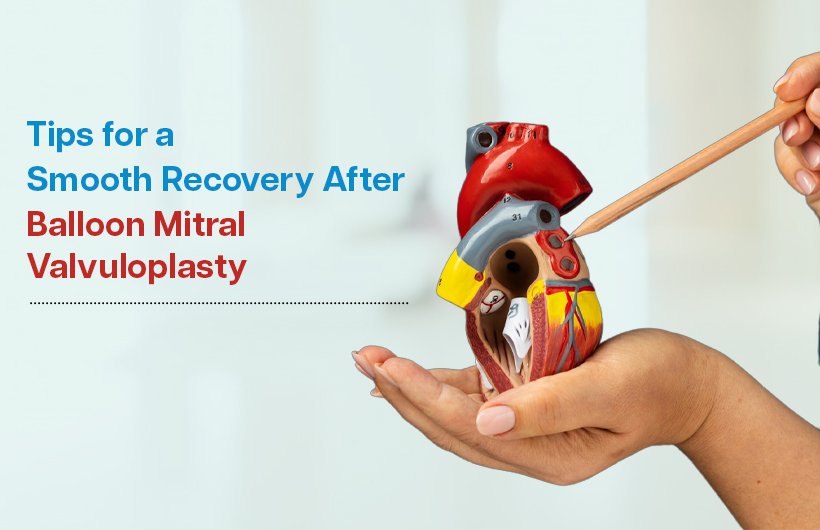BMV, short for Balloon Mitral Valvuloplasty, is an outpatient, minimally invasive procedure to treat mitral valve stenosis, a condition where the mitral valve in the heart narrows, hampering blood flow. This procedure has significantly benefited patients who would otherwise require open-heart surgeries. However, recovery after the procedure is crucial for the success of this treatment and the long-term health of the patient.
In this blog, we’ll discuss what to expect during the recovery process, the precautions you should take for smooth healing, and why consulting with a top cardiologist is vital for your full recovery.
Understanding the Procedure
Before discussing recovery, let’s understand what mitral valvuloplasty is. A cardiologist inserts a balloon-tipped catheter through a vein in your groin, which is then threaded to the narrowed mitral valve. Once the catheter is in place, the balloon is inflated to open the valve, allowing better blood flow. This minimally invasive technique is ideal for those with mitral stenosis who are not suitable candidates for surgery.
Immediate Post-Procedure Care
After undergoing the procedure, you will be monitored in the hospital, typically for 24 to 48 hours. Your heart rhythm, blood pressure, and overall condition will be closely observed to ensure there are no complications. Here’s what you can expect:
- Monitoring: You’ll be connected to an ECG monitor that tracks your heart’s activity. Blood pressure and oxygen levels are also continuously monitored.
- Bed Rest: You’ll need to stay in bed for several hours after the procedure to reduce the risk of bleeding at the catheter insertion site.
- Medications: You may be given blood-thinning agents to prevent clot formation, along with other medications to maintain heart rate and rhythm within safe limits.
Recovery at Home
Once you return home, following your cardiologist’s guidelines is crucial for a smooth recovery. Focus on the following key areas:
1. Wound Care
Care at the catheter insertion site is essential to prevent infections:
- Keep It Clean: Gently wash the area with soap and water, then pat dry.
- Monitor for Infection: Look for signs like increased redness, swelling, or discharge. Contact your cardiologist immediately if you notice these symptoms.
- Avoid Strenuous Activity: Refrain from heavy lifting or intense physical activity for at least a week to allow the incision to heal properly.
2. Medications
You will likely be prescribed certain medications to aid in your recovery, including:
- Blood Thinners: To reduce the risk of blood clot formation.
- Heart Rate Medications: Beta-blockers or calcium channel blockers may be prescribed to manage heart rate and blood pressure.
- Antibiotics: If there is a risk of infection, antibiotics may be given.
It’s vital to follow the medication instructions provided by your cardiologist to prevent complications.
3. Diet and Lifestyle Changes
A heart-healthy diet plays a significant role in your recovery and long-term heart health. Consider the following dietary tips:
- Low Sodium: Reduce salt intake to help control blood pressure.
- High Fibre: Incorporate whole grains, fruits, and vegetables to maintain a healthy weight and lower cholesterol.
- Healthy Fats: Choose unsaturated fats like olive oil and omega-3 fatty acids from fish.
- Limit Alcohol and Caffeine: These can affect your heart rhythm, so consume them in moderation.
Maintaining a healthy weight and avoiding smoking are also essential. A nutritionist or dietitian can provide additional guidance tailored to your needs.
4. Physical Activity
Light exercise is encouraged as you recover, but it’s important to start slowly:
- Begin with Walking: Start with short walks and gradually increase your distance.
- Avoid Overexertion: If you experience chest pain, shortness of breath, or unusual fatigue, stop the activity immediately.
- Consult Your Doctor: Before starting any new exercise regimen, discuss it with your cardiologist to ensure it’s safe.
5. Follow-Up Appointments
Regular follow-up appointments with your cardiologist are crucial to monitor your heart’s healing. During these visits, you can expect:
- ECG and Echocardiogram: These tests help assess your heart’s function, including the mitral valve.
- Medication Adjustments: Based on your progress, your doctor may adjust your medications.
- Lifestyle Guidance: Ongoing advice on diet, exercise, and other lifestyle factors will help you maintain heart health.
Attending these follow-up appointments is vital to ensuring a full recovery and preventing long-term complications.
Possible Risks
While mitral valvuloplasty is generally safe, there are potential risks, including:
- Bleeding: Particularly at the catheter insertion site.
- Blood Clots: Which could lead to stroke or other serious complications.
- Mitral Regurgitation: The mitral valve may not close properly, causing blood to leak back into the heart.
- Infection: Either at the catheter site or in the heart itself.
If you experience severe chest pain, shortness of breath, or irregular heartbeats, contact your cardiologist immediately.
Long-Term Care
Even after a successful recovery, long-term care is necessary to keep your heart healthy, including:
- Regular Check-Ups: Ongoing monitoring by your cardiologist ensures the long-term success of the procedure.
- Healthy Living: Continue practising heart-healthy habits such as a balanced diet, regular exercise, and not smoking.
- Stress Management: Manage stress through relaxation techniques, meditation, or counselling to support heart health.
- Awareness: Stay informed about your heart condition and be vigilant for any new symptoms.
Conclusion
Recovery after mitral valvuloplasty is a crucial phase that requires careful attention to medical advice, lifestyle adjustments, and regular monitoring. By consulting with a top cardiologist in Ahmedabad, like Dr. Jignesh Patel, who is renowned for his expertise and patient care, and following a tailored recovery plan, you can optimize your heart health and enjoy a better quality of life. Dr. Patel’s guidance through each step of your recovery will ensure that you achieve the best possible outcome from the procedure.






